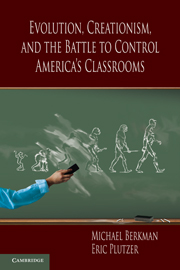Book contents
- Frontmatter
- Contents
- Figures
- Tables
- Acknowledgments
- Introduction
- 1 Who Should Decide What Children Are Taught?
- 2 The Public Speaks: “Teach Both”
- 3 A Nation Divided by Religion, Education, and Place
- 4 Is Evolution Fit for Polite Company? Science Standards in the American States
- 5 Teachers and What They Teach
- 6 State Standards Meet Street-Level Bureaucracy
- 7 When the Personal Becomes Pedagogical
- 8 Teachers in Their Schools and Communities
- 9 The Battle for America’s Classrooms
- Appendix to Chapter 2
- Appendix to Chapter 3
- Appendix to Chapter 4
- Appendix to Chapter 5
- Appendix to Chapter 6
- References
- Judicial Opinions and Court Cases Cited
- Index
6 - State Standards Meet Street-Level Bureaucracy
Published online by Cambridge University Press: 05 June 2012
- Frontmatter
- Contents
- Figures
- Tables
- Acknowledgments
- Introduction
- 1 Who Should Decide What Children Are Taught?
- 2 The Public Speaks: “Teach Both”
- 3 A Nation Divided by Religion, Education, and Place
- 4 Is Evolution Fit for Polite Company? Science Standards in the American States
- 5 Teachers and What They Teach
- 6 State Standards Meet Street-Level Bureaucracy
- 7 When the Personal Becomes Pedagogical
- 8 Teachers in Their Schools and Communities
- 9 The Battle for America’s Classrooms
- Appendix to Chapter 2
- Appendix to Chapter 3
- Appendix to Chapter 4
- Appendix to Chapter 5
- Appendix to Chapter 6
- References
- Judicial Opinions and Court Cases Cited
- Index
Summary
In the state of Virginia, we have the state SOL's (standards of learning) that students must pass to earn their diploma. We do not have any choices on what we want to or should teach, it is already outlined for us.
Virginia Teacher (2007)Although standards for teaching science have been touted as important for the reform of science education, they often mean little in biology classrooms.
Randy Moore (2002)From biology classroom to biology classroom, American students in the same grade receive very different instruction in evolutionary biology. For some, evolution will be the central organizing concept of the entire biology class, consuming considerable classroom time throughout the academic year, taught by teachers who endeavor to communicate the scientific consensus. Other students will have teachers who address it only briefly, or with characterizations of scientific discovery that bear little resemblance to what practicing biologists believe is most important; evolution in these classrooms may be presented skeptically if not fundamentally undermined. Some even teach nonscientific alternatives.
Our National Survey of High School Biology Teachers does not distinguish among the many pedagogical techniques and tools for teaching evolution and biology (Alters and Nelson 2002; Ingram and Nelson 2006; Wilson 2005), but our first look in Chapter 5 does show significant variation on the attention given to it, in terms of time, and whether teachers emphasized perspectives that bear on its overall legitimacy. This variation in teaching practices does not come from the scientific community, where no controversy exists except over the details of how evolution works. So what does explain it? We begin our exploration of that question in this chapter by examining whether the differences in state content standards that we identified in Chapter 4 can account for some of the variance among teachers.
- Type
- Chapter
- Information
- Publisher: Cambridge University PressPrint publication year: 2010



